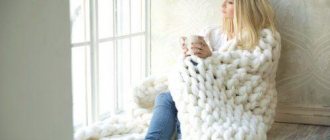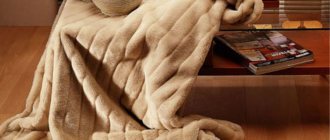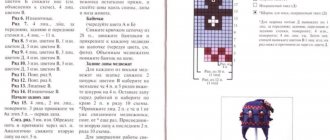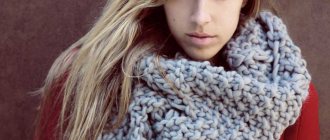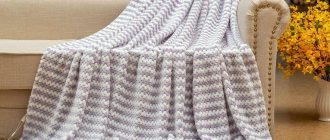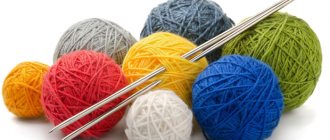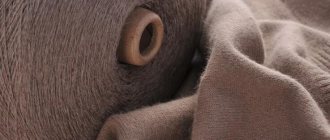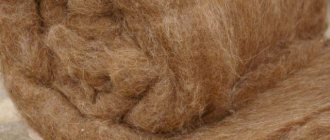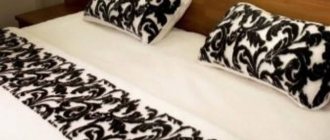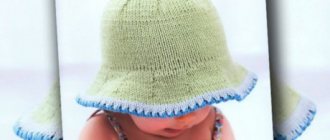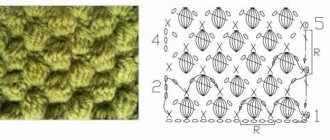Types of blankets
Knitted options of modern design will fit perfectly into any stylistic solution for decorating the space of the room. The accessory is appropriate in the bedroom instead of a traditional bedspread, it will decorate the living room, complement the office, or the nursery. Volumetric, textured blankets and capes vary in color, size, and pattern. They are often produced in pastel colors that evoke peace.
Products can be classified into factory-made and hand-made, uniform and patterned. Braids, relief, squares and rectangles are knitted on blankets. They can be plain or colored, with a contrasting combination or stripes in the same color scheme.
Pros and cons of blankets
The products organically combine comfort and beauty. A blanket made of thick yarn is a fashionable design element. The canvas is valued by designers for its versatility and is used as decor:
- balance the color composition;
- refresh tired upholstered furniture;
- serve as a bright accent in the bedroom;
- complement the surroundings.
The models replace homemade sweaters, save you from the cold and autumn chilliness, and are comfortable to wrap yourself in knitted gutta-percha fabric. Wool products have healing properties. Used to treat joint problems, relieve pain due to osteochondrosis.
Among the disadvantages, it is worth noting delicate care, the ability to cause allergies, and accumulate dust. Knitted fabrics stretch when handled harshly; due to intensive use, the appearance of the products noticeably deteriorates and loses its elegance.
Important! When purchasing knitted blankets, you need to be prepared for pilling and shaggyness. The thread does not retain its original smoothness for long.
Knitwear takes on any shape, stretches, fills the contour of a stroller, or a child's car seat. The child is satisfied and happy.
Material
The composition of the yarn is not regulated by a standard; each manufacturer develops its own. Merino ribbon is considered the best - the fiber is cleaned, dyed, combed, and lightly felted. To reduce the cost of products, sheep wool, angora, mohair, acrylic, and polyester are added. Synthetics are usually produced in the form of strands. Fabrics are also knitted from thick children's yarn Puffy and Alize.
For large knitting, craftswomen also use twisted and regular factory yarn in several threads to achieve the required volume. Such products do not seem uniform, are a little stiffer than merino, thinner, and hold volume less well.
Blanket sizes
An important selection parameter is the format of the knitted fabric. The self-knitted blanket has a thick knit. The format is arbitrary. Manufacturers offer ready-made accessories for various purposes:
- for blankets, the optimal format is 140..160x200...220 mm;
- It is comfortable for young children to sleep under a 90x90 blanket;
- knitwear in the 100x150 mm format is used as capes.
Available in sizes 130x170 for traveling by car, Euro 220x220 for large sofas and beds.
Combinations of harmonious colors are acceptable; pastel natural shades are usually chosen. Small multi-colored blankets will make an excellent bedside rug that is pleasant to stand on.
Blanket shape
Knitted fabrics are usually rectangular or square in shape. When crocheting yourself, you can design thick, thick knitted blankets, oval or round, if you start crocheting from the center. When working with knitting needles, decreases and increases will be too prominent, so immediately cast on a certain number of stitches with knitting needles, form an even fabric, and adjust only the length. The use of a pattern does not affect the shape, only the texture changes.
Equipment
Products are packaged in polyester bags to prevent the fibers from fraying during transportation and storage. Sometimes rolled blankets are packaged in polyethylene and tied with a wide ribbon with a label indicating the composition of the raw materials, care rules (washing, drying, dry cleaning, etc.).
For reference. On some websites, craftsmen and designers offer sets with covers for pillows of standard sizes. Children's sets include a rug, a crib mattress, and a blanket.
Manufacturers offer all kinds of pastel colors, pink shades, gray and beige are popular.
DIY chunky knit merino wool blanket
There is no more cozy, original, truly homely textile than a large knitted blanket. Huge knitting has become a fashion trend. It is interesting both for knitters and connoisseurs of extraordinary things. For those who have the necessary materials and free time in stock, useful tips on making such self-knots will come in handy.
This is what a chunky knit merino wool blanket looks like
Blankets made from thick yarn - elegant luxury of comfort
The most successful purchase for your home will be a merino blanket. Finished products are found in the collection of the American brand Modern Wool. But prices for branded goods are steep, and delivery will cost a hefty sum. It is much more interesting and cheaper to knit a product from merino wool yourself.
Merino blanket is a high-quality product that has a completely natural composition
Thick knitting thread is available to a wide range of consumers. You can knit from conjugated fibers and combed tape.
Thick merino wool yarn in a skein
The latter is popular among knitters, but items made from unprocessed material have disadvantages:
- they cannot be washed;
- the finished product is prone to deformation;
- When working with tape, there is a high probability of rupture due to the low strength of the raw material.
Twisted merino thread is more expensive, but much better. It does not stretch, break or split into fibers. The self-knitting will not lose its shape, and with careful care it will last for many years.
Delicate, thornless, premium twisted thread made from fine merino wool fibers
Ready-made merino knitting is cozy, homey, warming and pleasant to the touch. Items made from worsted wool cannot be compared with products made from synthetic fibers and knitted cord.
Merino wool is hypoallergenic and antibacterial thanks to lanolin, a natural antiseptic, and therefore suitable for children
To make a large knitted blanket with your own hands practical and beautiful, you need special yarn. Usually twisted merino thread is used. Combed ribbons made from wool fibers are considered a more affordable option. You can make a coarse-knit blanket or rug from knitted cord.
All that remains is to figure out how to create a soft blanket at home. If everything is clear with the choice of material, then the question regarding the tools remains open. Regular hooks will not work. Unfortunately, large-diameter tools are not sold in all stores.
Thick wooden knitting needles are quite suitable for knitting
Available means will come to the rescue: plastic tubes with a cone-shaped top, tightly rolled rolls of paper tied with tape, etc. The circumference of the tube can reach 20 cm or more. The thicker the thread, the larger the diameter should be.
A device for knitting a chunky knit blanket
Merino wool produces fluffy and light garments on large knitting needles. If you work with crochet, the fabric will come out thin. This solution is suitable for rugs and bedding, but blankets and bedspreads should be made more loose and soft.
The blanket can be knitted not only with stockinette stitch, but also with patterns
Ultra-fashionable chunky knit blanket without knitting needles
You can knit a blanket from cut strips of knitwear or combed ribbon without using the usual knitter tools - knitting needles and hooks.
Wool combed into a ribbon for felting is often called combed ribbon or tops
Thick merino wool produces voluminous fabrics made directly on the hands.
We start casting on loops on our hands
Add the second and next loops
The set is carried out on the brush, after which the resulting rings are folded into an even line without tension.
When casting on loops, you need to monitor their size
Next, the yarn is unwound to complete the first row. New loops are formed from it and pulled into existing ones. At the same time, the knitting remains, as it were, open, because there is nothing to hold the thread. However, this does not interfere with work. Due to the thickness and heavy weight of the yarn, nothing slips.
We knit the second row of our blanket on our hands
Without special tools, you can knit with front and back stitches, braids and plaits, and simple patent patterns. The last row is closed as usual: a new thread is threaded through two loops, it is thrown over the next loop and pulled out again. And so on until the row is completed.
We close the loops of the last row
The main problem when working with this technique remains maintaining even rows. If the knitting needles have a specific diameter, then the thickness of the hands varies. For this reason, it is not possible to make the broaches absolutely even, and skill is required when working.
Do-it-yourself ready-made gray blanket from thick yarn
How much yarn do you need?
You can knit a blanket from thick yarn in a short period of time, because a couple of rows are enough to cover a significant area. The thread consumption is significant, so the skeins often have a larger volume than for traditional knitting. How many skeins you need depends on the desired size. It is recommended to adhere to the following scheme:
- a children's model up to 120 cm in length will cost 2 kg;
- for a product measuring 100 X 170 cm (plus or minus in one direction or another) you will need about 4 kg;
- for a full-fledged blanket for an adult, 5.5–6 kg of material is needed.
Blankets from fragments: knitting and sewing
An original blanket made from merino yarn made from multi-colored fragments sewn together
Knitting in the patchwork style is always popular, because it allows you to rationally use leftover yarn and your own imagination to create masterpieces of home textiles.
Bright and warm, soft to the touch “Autumn” blanket made of thick merino wool
For a product with a voluminous texture, you will need tools of impressive diameter, but not as huge as for seamless knitted fabrics. You can sew together scraps of different sizes and textures. The main thing is to steam all the pieces before stitching so that they take the final shape. Otherwise, the finished blanket will be lopsided.
A beautiful “Chess” blanket can be knitted from individual elements or as a whole fabric
Flaps can be made from any available raw material. It is best to sew the resulting fragments together with a contrasting thread, then the canvas will turn out to be especially expressive and bright. The same thread should be used to crochet the product around the perimeter.
To connect threads during knitting and when tying individual elements, it is better to use a special needle for felting
Pompom blanket for children and more
Parents always want to create something special for their kids. Excessively large loops and stockinette as a pattern may seem too rough for children's skin. Blankets made from pompoms look much more attractive in appearance and feel more pleasant to the touch.
They are easy to do, but preliminary preparation is important. First you need to create a frame, the dimensions of which should be slightly larger than the desired result (on the frame the canvas will be stretched). Long nails are driven in along the perimeter of the frame in increments of 4-5 cm. They should stick out from the block by at least 5 cm.
If the pompoms are voluminous, then the entire size is 8-10 cm.
Preparing a wooden frame for threads
Next, take the warp thread (otherwise known as the backing thread) and wrap it around the nails. This must be done in a certain order. First come the horizontal rows, then the vertical ones. The procedure is repeated several times.
We wind the threads in rows horizontally and vertically, alternating
If a pattern is planned, the color is changed. To get variegated pompoms, take more than three colors. It is important that the thread is of the same thickness and similar composition. After winding, the joints are secured with knots.
We tie all intersections with reliable strong knots to prevent unraveling
And then the colored tensions are cut without affecting the substrate. The result is lush pompoms. The threads around the perimeter are also cut, leaving them in the form of tassels.
To form pompoms, cut the threads with scissors in the middle between the intersections
For a baby, such a thing will be a real gift, and if you make the frame larger, you will get a lush and cozy blanket for an adult.
A beautiful fluffy baby blanket with your own hands is ready
50 beautiful warm and cozy chunky knit merino wool blankets:
We recommend articles on the topic
Satin - what kind of fabric is this for bed linen?
Satin is a unique fabric that resembles silk fibers in appearance and is not inferior in quality to cotton. It was known in ancient times, but became popular only in the last century...
Bed linen manufacturers
A person spends quite a large part of his life sleeping. We no longer notice it, but we spend a lot of time sleeping, moreover, sleep is an important and integral part of our life. So do...
Choosing a blanket for a newborn
To ensure a comfortable life for a newborn, you need to take care of many things. One of them is healthy sleep, which is impossible without the right baby blanket. This article details how...
Poplin fabric for sewing bed linen
For a healthy and sound sleep, it is necessary to organize your sleeping place correctly. The bed should be comfortable, the mattress should be moderately hard. Bed linen is of great importance. High-quality fabric can...
How to fold a fitted sheet
Anyone can probably find a sheet with an elastic band. This is a practical, comfortable piece of bedding. Due to the elastic band at the edges, it is firmly fixed to the mattress. It's a pleasure to sleep on it. Not…
Calico fabric and its application
One of the most popular fabrics is calico fabric. Its use in Rus' began in the 16th century. A natural cotton product that does not cause allergic reactions or irritation to the skin, therefore...
Source: https://berkem.ru/tekstil/pled-krupnoj-vyazki/
How to choose a blanket
Blankets made from yarn have an amazing ability to enliven the interior, making it comfortable and cozy.
Coloring is a matter of taste; the main thing is that the blanket is in harmony with the interior. When it is not possible to touch the product with your hands, the composition of the fiber is studied. Visually evaluate the knitting: pattern, texture, size of loops, density of knitwear.
When purchasing things on websites, it is advisable to look at customer reviews and ask friends which brand deserves attention. Masters offer many wide canvases of their own production. For self-knitted products, it is important to know the exact format in advance; the functionality of knitted products ultimately depends on this. Small blankets are convenient to take with you when traveling. It is customary to cover the floor with huge blankets instead of a carpet or use them as a blanket for upholstered furniture and beds.
Which is better
When choosing a merino wool blanket, you need to pay attention to the size of the loops, the composition of the yarn and the density of the weave. With a low knitting density, the fabric quickly deforms. For voluminous products, the loops reach 15 centimeters in size, but such fluffy knitwear will quickly become covered with pellets and become fleecy.
Products made from mixed yarn are more practical, acrylic is easier to wash and less deformed. Interior accessories made of acrylic fiber do not differ in appearance from natural ones; synthetics are soft to the touch, do not fade from ultraviolet radiation, and do not provoke allergies. Only such knitwear allows air to pass through worse than merino knitwear, accumulates static electricity, and does not absorb perspiration. Pure wool is warmer and softer, more pleasant to the touch. Blankets made from knitted cord are bulky, but they warm worse than wool and are lighter in weight.
Note! Any large knit blanket is comfortable and cozy. Many people make a choice based on color, this is justified, the main thing is to achieve harmony in the design of the space.
What is merino wool
These are natural fibers obtained after shearing sheep of a unique breed. Soft wool, devoid of hard spine, is subject to selection for the production of the most elite thread. The content of lanolin, which has an antiseptic effect, repels dust mites and other parasites.
Merino
The long fibers of the wool make the thread elastic, and the finished product retains heat. For people prone to allergies, any item made from merino wool will be suitable.
For your information! The origin of merino, like plaids, is associated with several historical confirmed data, having different roots. According to some sources, the sheep breed was developed in Ireland, while others refer to the French Merino Ramboulier, obtained by crossing Spanish and English long-wool, fine-wool breeds.
The resulting specimens were exported to the USA and Austria. They came to Russia to Soviet livestock specialists from their American colleagues. The Irish origins of the fine-wool sheep, which were banned from export for nearly six centuries, give rise to the story of the invention of knitted blankets in Northern Scotland.
Note! Attempts to export valuable yarn outside the historical homeland were punishable by death. The distribution of woolen products was also prohibited to owners of sheepfolds. There was no talk about selling the valuable breed for many centuries.
A blanket made from merino wool, obtained from a special breed of sheep, has amazing properties, and products of this quality could only be owned by people of noble origin.
Now times are no longer the same. Merino wool has become widespread in recent years. The rise in popularity of products made from merino wool is only gaining momentum. Along with blankets, customers are offered hats, sweaters and snoods. Yarn for making items with your own hands has become available for sale quite recently.
You might be interested in what stretch consists of: description of the fabric, its application and operation
Long fibers
Care
A hand knitted blanket needs to be cared for gently. It is better to wash by hand, as the machine will quickly form pills. It is recommended to use shampoo or wool products.
Labels of finished products often indicate a triangle, this means the knitwear can be washed in a machine, you just need to set it to delicate or hand wash mode, the water temperature should not exceed 30°C. It is important to consider the composition; if sheep fiber is added, the products are more resistant to deformation. It is forbidden to use bleach; the blanket will roll up. Drying needs to be natural. First, the knitwear is allowed to drain well, then it is spread out on a flat horizontal surface to avoid deformation. Do not clean coarse knitwear with brushes; it will instantly become shaggy.
Note! When there are severe stains, dry cleaning will help remove them.
This is what voluminous knitting threads look like, wound from a bobbin into a huge ball. Handicraft requires operational space.
How much yarn do you need for a blanket?
You will need wool and wool blend merino roving without twist or felted tape. Yarn for hand knitting is usually marked by meter and in grams. In master classes, the number of skeins is often indicated. It’s difficult even for experienced knitters to navigate by footage. Using the trial and error method, average indicators were derived that can be used as a guide when calculating the required number of threads.
For a small children's blanket with a format of 80x120 cm, 2 kg of merino fiber is enough. For medium-sized products, approximately 1x1.5 m, you will need 3 kg. A full duvet for a double bed will weigh up to 6 kg (meaning size 1.5 x 2 m). For a cover on a sofa with a format of 1.3x1.7 m you need 4.5 kg.
Important! It is better to purchase yarn in large skeins. With an average knitting density, the fabric will be a meter wide and up to 1.4 meters long.
When creating medium-sized blankets, hands successfully replace knitting needles; the knitting technique is standard.
How to knit a blanket
Weaving is chosen as usual, purl row, front row. Looks good alternating purl and knit stitches. The result is a blanket with small bumps. If desired, you can weave openwork options and complex patterns from bulky merino yarn. There is nothing complicated in the weaving technique; a schoolboy can handle it.
Beginners can use videos from the Internet. It is better to watch educational videos with pauses or at slow speed. When knitting, it is important to discard, without knitting, the first loop in the row so that a neat braid is formed along the edge.
By the way, on average, for a meter width you will need from 16 to 20 loops, depending on the density of the fabric. Giant chunky knit blankets require knitting needles and only a limited number of stitches per hand. Dense and heavy items made from unspun merino threads or combed ribbon yarn are obtained when crocheted, you will need tool No. 16, 18 or 20. For crochet, the best material is Caucasian or Turkish acrylic or Puffy or Alize threads.
For reference. Instead of knitting needles, tubes with cone-shaped tips and rolled sheets of paper covered with masking tape are used. You can experiment with other items.
How to knit a chunky merino wool blanket with your own hands. How to wash a blanket
Thick knitted merino wool blankets have become a hit in interior fashion and have acquired the status of a fashion trend. How to knit a chunky merino wool blanket with your own hands to decorate your interior, read in this post. And also about how to care for and wash a large knit merino wool blanket.
style=”display:block” data-ad-client=”ca-pub-0912490692426417″ data-ad-slot=”9364934307″
data-ad-format="auto">
Let's start with what merino wool is and why products made from merino wool have gained popularity.
To quickly warm up in a cold bed, an electric sheet in Ukraine is effective; this product is safe and consumes little electricity. You can take an electric sheet with you to the dacha, on a hike, or use it at home in the off-season when there is no heating yet or no longer.
What is merino wool and its properties
Merino wool is unique, it has antibacterial properties, is very soft and does not itch at all, and absorbs moisture well. At the same time, merino wool is incredibly light and even bulky items, such as a merino wool blanket, will be almost weightless.
Merino wool is produced from the fine-fleece Merino sheep of the same name. This is a special breed of highland sheep from Spain that was brought to Australia and New Zealand in the 18th century, where they are now bred. Australia has become the world leader in the production of merino wool.
Merino sheep are valued for their high ability to produce wool; up to 15 kg can be obtained from one sheep per year. wool, while representatives of other breeds produce only 6-7 kg. wool per year. The value of merino wool is that it is light, hypoallergenic and very thin, its thickness is 15-23 microns, while sheep of other breeds have a wool thickness of 24-35 microns.
Depending on the thickness of the hair, merino wool is divided into 4 conditional categories; the thickest hairs, 20-24 microns, are the cheapest and most common, they are suitable for machine knitting. Large knit blankets are also knitted from this wool, which have become popular.
The finest merino wool is called Summer wool, the hair thickness is only 14-15.5 microns, its volume is only 0.1% of the total merino wool production and is sold at special annual auctions. Golden Bale summer merino wool is used to make very expensive fabrics and knitwear.
Even the least expensive merino wool is quite expensive and therefore a certain amount of synthetic threads is added to it to reduce the cost. By the way, the color of merino wool is exclusively white.
How to knit a chunky merino wool blanket with your own hands
To knit a chunky merino wool blanket you will need a tool, in this case knitting needles, a crochet hook or... just your hands. You can buy knitting needles or a hook of the appropriate size for large knitting in online handicraft stores, or you can knit a blanket simply by hand, because The thickness of the wool is very large. There is information that when crocheting a blanket, 30-40% more yarn is used.
Calculation of yarn for knitting a large knit blanket
In order to knit a large-knit merino wool blanket 120*210 cm, you will need about 3 kg. wool, but considering that the price of merino wool for knitting blankets in handicraft stores is about $25-30 per kg. and higher, it is better to calculate more accurately how much merino wool is needed. The finished product reaches a price of $300-400
To calculate the yarn consumption, you should purchase one skein of wool from which you want to knit a blanket, knit a fragment of a product measuring 5*7 cm from this yarn using the knitting needles with which you are going to knit the blanket.
After that, wash and dry the knitted sampler, in the dried state, measure the knitting density - the number of rows and loops obtained in each row; then unravel the probe and measure the length of the thread used.
You can also use an online calculator to calculate the yarn for a knitted product.
As a rule, large-knit merino wool blankets are knitted using standard stockinette stitch. How to knit a chunky merino wool blanket with your own hands, watch the video.
If you have little skill, it will take only a few hours to knit a massive blanket, because bulky threads quickly create the area of the product. If suddenly something goes wrong, don’t be upset, you can unravel the blanket and start all over again, knitting a chunky knit blanket is pure pleasure, the result of your labor is born right before your eyes.
How to wash a merino blanket. Features of care
You can wash a coarse knit merino wool blanket at 30C, preferably with liquid detergents containing lanolin. When washing a blanket, you should avoid rubbing and stretching the product; to remove water, the blanket should be gently wrung out, but not twisted. It should be dried in a horizontal position; if necessary, use dry cleaning.
How long to knit by time
Having mastered the technique of making purl and knit stitches, making a blanket is not problematic. The speed of knitting depends on the skill of the craftswoman and her skills in working with knitting needles. It only takes a few hours to make a small blanket using thick yarn by hand. From 2 to 4 hours is needed to make a medium format blanket.
Merino wool, felted into a thick rope on large knitting needles, produces fluffy and light little things for newborns. You can knit an envelope or a soft floor mat to lay out the babies. The weaving should be made loose to preserve the softness and tenderness of the merino fibers.
Note! It is better to knit fabrics in the off-season, when the room is cool. Wicker fabrics are mega hot.
Making a gray mattress for a stroller using special knitting needles; they are often sold complete with yarn.
A modern coarse-knit merino blanket will become a fashionable accent to any interior; it will create an atmosphere of home comfort and harmony. You can make an original accessory with your own hands. Children like small merino blankets and blankets; they are convenient to use at home and on a walk.
Choice
A series of warm blankets Magic Night filled with natural merino wool brand Nordtex
Things to consider before purchasing:
- the time of year for which the item is intended;
- how the body tolerates different temperatures, whether it likes coolness or warmth;
- comfortable under a thin blanket or like the security of a heavy one;
- it should be in a cover or with the wool facing out.
What to look for when purchasing:
- Case material (if available). The best options are natural jacquard, satin or calico. They are strong, durable, breathable, and pleasant to the touch.
- A blanket made from Australian merino wool must be marked with the source material.
- Presence of odor. Sheep wool has it, but it may not exist if all technologies are followed. There definitely shouldn’t be a chemical or unnatural smell. Even if the composition is completely natural, these may be the consequences of chemical processing that should not exist.
- A high-quality blanket, with or without a cover, does not have lint sticking out. You can get them from the inside with some effort. There should be no crooked stitching or protruding threads.
- Quilting options: parallel, squares or patterns. The last two are better.
- Weight and cost of the product. If it is light or costs up to two thousand rubles, it means there are synthetic impurities.
- The label of a good product indicates the density, weight, composition of the filler and cover, dimensions, and care tips.
- 100% natural merino filler is marked with the word NOMITE.
You should only buy a blanket for your child if it fits. There are different sizes, even for the smallest ones. If the child does not mind a heavy blanket, you should take a larger size. Children grow faster than the life of the blanket. But if you have allergies, it is better to go with the synthetic version.
Important
For the healing properties to be effective, contact between fur and skin is necessary. You will need a pure wool blanket without a cover or duvet cover.
Dimensions
The merino blanket has the following dimensions:
- for infants, newborns 80x80 cm or 80x100 cm;
- children under 10 years old 1.1x1.4 m;
- single bed 1.5x2 m;
- double bed 1.8x2.1 m;
- European version 2x2.2 m;
- king size 2.4 x 2.6 m.
These are commonly found sizes for merino blankets.
